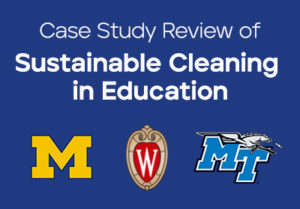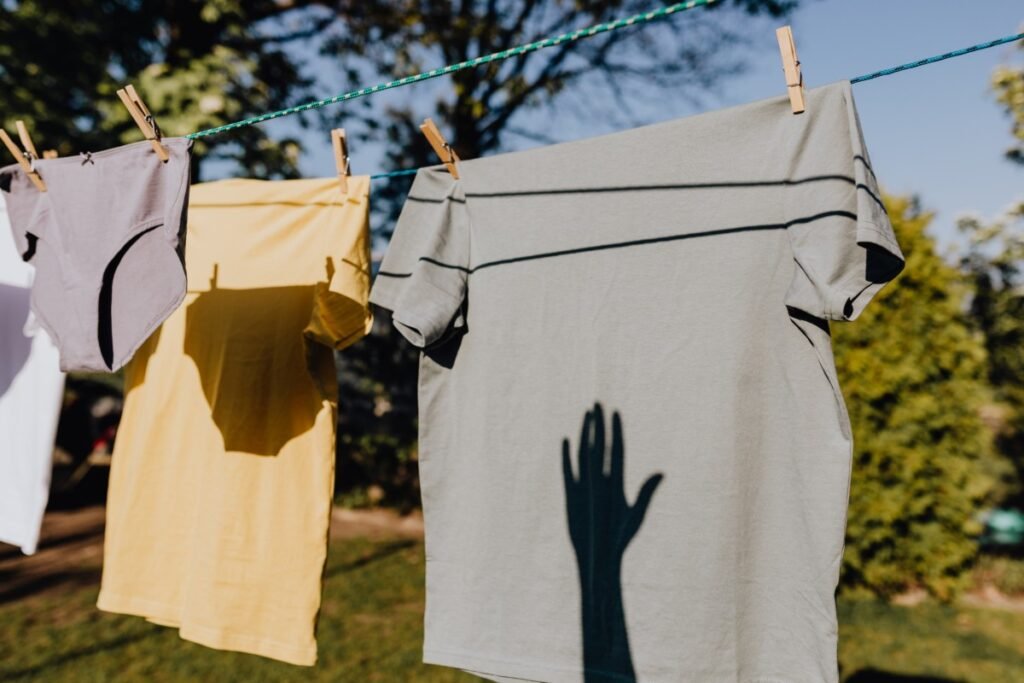
With goals to increase sustainability, safety and cost-savings on campus, Middle Tennessee State University, the University of Michigan and the University of Wisconsin-Madison innovated their cleaning programs by replacing their use of traditional cleaning chemicals with Stabilized Aqueous Ozone (SAO®).
Stabilized Aqueous Ozone piqued the three schools’ curiosity due to its unrivaled sustainability: the solution kills 99.999% of germs yet contains no harsh chemicals. Instead, it harnesses the power of natural ozone to oxidize and eliminate germs, including those responsible for the novel coronavirus disease.
This case study review analyzes the trials, implementations and results of the three schools’ transitions from traditional cleaning chemicals to Stabilized Aqueous Ozone – a simple change that dramatically improved sustainability, safety and cleaning cost-efficiency on campus.
Middle Tennessee State University Meets Sustainability Goals with SAO
When Middle Tennessee State University (MTSU) slated plans to increase sustainability in their campus cleaning program, Stabilized Aqueous Ozone proved to be a simple, actionable and effective solution.
Trial and Implementation
Middle Tennessee State University conducted a month-long trial of SAO in one of its several academic buildings. The trial’s objective was to demonstrate how SAO was on par with or exceeded the performance and efficacy of traditional cleaning chemicals while being able to help them reach their sustainability goals. Once staff and faculty saw the results of Stabilized Aqueous Ozone, they immediately embraced it as a promising solution that could effectively replace and outperform traditional cleaning products. Their results from transitioning from conventional cleaning products to SAO are as follows.
Reduced Harsh Chemical Usage
As an all-in-one, sustainable solution, SAO allows MTSU to achieve cleaning product consolidation while dramatically eliminating their need to use harsh cleaning chemicals on campus. Because SAO contains no polluting chemicals, switching from traditional cleaning products to SAO supports MTSU’s sustainability goals by allowing them to keep harmful chemicals, VOCs and pollutants out of their local air and waterways.
Reduced Carbon Emissions
Adding to SAO’s sustainability for MTSU is the fact that it utilizes on-site generation. A wall-mounted device turns ordinary tap water into SAO on-site and on-demand within seconds, providing resource security for MTSU while helping them reduce their contribution to scope 3 carbon emissions from the supply chain of traditional cleaning products.
Reduced Water Usage
As a residue-free solution, MTSU’s transition from traditional cleaning products to SAO helps them conserve water. SAO is a unique solution because it reverts to water and oxygen and does not require surfaces to be rinsed with water after cleaning. The butterfly effect of cleaning with a no-rinse solution is a dramatic reduction in water usage, which helps MTSU preserve one of the earth’s most vital resources.
Reduced Plastic Usage
Because Stabilized Aqueous Ozone utilizes on-site generation, MTSU no longer needs to purchase cleaning products in single-use plastic spray bottles. Instead, they dispense the SAO solution from the device directly into mop buckets, reusable spray bottles, scrubber-driers and any other cleaning equipment of their choice. By reducing their single-use plastics consumption, MTSU reaches yet another sustainability benchmark by incorporating the Stabilized Aqueous Ozone cleaning program.
“Switching from traditional chemicals has enabled us to reduce our carbon footprint,” states Brain Addington, Unit Director of Facility Services at MTSU, “That’s important to our leadership as MTSU is always looking for ways to be more environmentally friendly.”
The University of Michigan Increases Safety on Campus with SAO
To improve safety, the University of Michigan sought out an alternative to cleaning with traditional chemicals on campus. Learning how Stabilized Aqueous Ozone has helped other higher education facilities improve their safety, the University of Michigan sought to understand how incorporating the solution on their own campus would also help them achieve their goals.
Trial and Implementation
After successful trials, the University of Michigan implemented Stabilized Aqueous Ozone on campus. The improvement of their campus’s sustainability, safety and cleaning effectiveness was so much that the residence hall custodial team was awarded the President’s Staff Innovation Award for replacing toxic cleaning chemicals with a zero-impact solution. The University of Michigan’s results from transitioning from conventional cleaning products to SAO are as follows.
Reduced Harsh Chemical Usage
With SAO, the University of Michigan makes their environment safer for students, staff and faculty by cleaning with a solution free of harsh chemicals. Like MTSU, the all-in-one solution provides the University of Michigan with cleaning product consolidation. Replacing most of their cleaning products with SAO astronomically reduces their use of harmful cleaning chemicals on campus, providing a safer environment for all occupants.
No More Offensive Fragrances
With no harsh chemicals, Stabilized Aqueous Ozone does not need powerful masking fragrances to hide distracting and offensive chemical odors. With no masking fragrances, switching from traditional cleaning products to Stabilized Aqueous Ozone allows the University of Michigan to create and maintain a fragrance-free cleaning program, providing a more comfortable and safe environment for those with fragrance sensitivities.
“Since we’ve switched to Stabilized Aqueous Ozone, I’ve gotten better,” remarks Marin Yaseem, custodian at the University of Michigan, “When I go home, my kids hug me, and they say I don’t smell like chemicals anymore. I call this a miracle.”
No More Slippery Floors
Because Stabilized Aqueous Ozone contains no harsh chemicals, the University of Michigan no longer has to worry about slippery chemical residues on their floors. By cleaning with a residue-free solution, the University of Michigan dramatically reduces the potential for dangerous slip-and-fall accidents and provides a safer environment for building occupants.
“This Stabilized Aqueous Ozone project is worthy of team recognition,” remarks Loren Pullman, Associate Vice-President of Student Affairs, “It sits at the nexus of cost savings, environmental and health consciousness, productivity, and the leadership role that the University of Michigan plays in higher education.”
The University of Wisconsin-Madison Saves Costs and Planet Earth with SAO
The University of Wisconsin-Madison followed suit in sustainably innovating their cleaning program with SAO. The University of Wisconsin-Madison takes pride in their ability to lead the country in research and innovation. There is no exception to this regarding how they clean and maintain their campus; thus, they chose Stabilized Aqueous Ozone to reduce costs associated with products, labor and cleaning consistency.
Trial and Implementation
Like Middle Tennessee State University and the University of Michigan, the University of Wisconsin-Madison implemented SAO after trials proved to successfully enhance their cleaning program’s safety, sustainability and cost-efficiency. The University of Wisconsin’s results from transitioning from conventional cleaning products to SAO are as follows.
Reduced Product Costs
Like MTSU and the University of Michigan, Stabilized Aqueous Ozone allows the University of Wisconsin-Madison to consolidate their cleaning products and replace most of their harsh cleaning chemicals with one certified safe and sustainable solution. By reducing the number of cleaning products on campus for a solution that requires only water, oxygen and electricity to create, the University of Wisconsin-Madison saves costs by no longer purchasing various expensive traditional cleaning products.
Reduced Labour Costs
Beyond saving costs associated with purchasing and transporting traditional cleaning chemicals, the University of Wisconsin-Madison also saves labor expenses with on-site and on-demand generation. Instead of mixing, diluting, storing, managing and disposing of harsh chemicals, the cleaning staff flip a switch on the SAO device and dispense the solution on demand, ready to use. Because SAO reverts to water and oxygen, it poses no harm to aquatic life and can be safely disposed of down the drain, simplifying chemical management for staff and saving time.
Reduced Costly Mistakes
Using a solution for the wrong application can result in expensive damage. With SAO, this is no longer a concern for the University of Wisconsin-Madison. With an all-in-one solution that is safe and effective for virtually all applications – classrooms, dorms, bathrooms, dining areas, hallways – the University of Wisconsin-Madison eliminates any room for application error with SAO.
“We have 41 Stabilized Aqueous Ozone dispensers in our buildings, and it is still a much cheaper way to clean and sanitize versus using traditional chemicals,” states Jodi Krause, Assistant Director of Housekeeping at the University of Wisconsin-Madison, “We’re saving over $25,000 annually by not buying harsh chemicals.”
More on Stabilized Aqueous Ozone
In the early 2000s, Canadian-based cleaning technologies company Tersano created and patented Stabilized Aqueous Ozone. To this day, they manufacture and distribute leading-edge technologies and devices that convert ordinary tap water into SAO on-site and on-demand. Their solution and technologies help various industries, like the educational sector, dramatically reduce their use and need for harmful chemicals while meeting sustainability, safety and cost-saving goals.
Tersano has been a long-time sponsor of AASHE and a preferred supplier as an AASHE Sustainable Campus Partner. Their solution and devices provide users with up to 4 STARS points and accreditation from LEED and WELL. For more information on Tersano’s products and innovation, please visit www.tersano.com.
About the Author
This article was produced by Kelsey Tannous, Marketing Manager and Content Creator of Tersano, who shares the company’s dedication to helping key industries recognize the benefits of replacing harsh chemicals with sustainable, more effective cleaning technologies.

